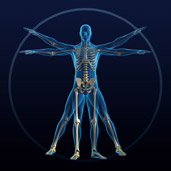
Orthopedics
Restoring the Tendons
 Tendons are cords of fibrous tissue that connect muscles to bones in the proximity of joints. When your muscles contract, it is the tendon that transmits the force. In the context of Traditional Chinese Medicine (TCM), the tendons empower one to utilize one's will to direct the exertion of muscular strength. They are crucial to human movement and biomechanical stabilization.
Tendons are cords of fibrous tissue that connect muscles to bones in the proximity of joints. When your muscles contract, it is the tendon that transmits the force. In the context of Traditional Chinese Medicine (TCM), the tendons empower one to utilize one's will to direct the exertion of muscular strength. They are crucial to human movement and biomechanical stabilization.
Repetitive activity, overuse of specific joints, and physical trauma could lead to tears within a tendon and consequently inflammation, pain, weakness, and swelling. This is called tendonitis (also spelled tendinitis). Tenosynovitis, inflammation of the sheath that surrounds tendons, often accompanies tendonitis, aggravating the duration and severity of the discomfort. A tendon tear that is more severe is referred to as a tendon rupture and may require surgery for optimum rehabilitation.
Since tendons receive less blood circulation than muscles, tendonitis usually takes a longer period of time to heal than muscle strain. If blood circulation is improved, however, the transfer of nutrients and oxygen to the injured tendon is optimized and the healing time is shortened. The integrative use of TCM modalities has been effective in improving circulation of blood to injured tendons. TCM enhances the release of the body's own biochemical molecules that reduce inflammation, dilate blood vessels, and block pain receptors.
The key components of TCM in the treatment of tendonitis are as follows:
ACUPUNCTURE sends signals through the peripheral and central nervous systems to initiate a healing response. Thus, it reduces inflammation and improves circulation of oxygen and nutrient-filled blood into the injured tissue.
MASSAGE – manual therapy (that may include herb infused oil) to break up tension resulting from prolonged tightening of the surrounding area. This "guarding" is a defense mechanism to protect the injured area. If it occurs well beyond the acute phase, healing time is slowed down due to tightened muscles constricting blood flow.
HERBAL THERAPY – taken internally (as a liquid decoction, pill, or capsule) and externally (as an herbal patch or liniment) to improve circulation and reduce inflammation.
ANTI-INFLAMMATORY DIET – the consumption of nutritious foods with natural anti-inflammatory properties to improve circulation of blood.
CHI GONG (Energy Exercise) – restorative movements using breath and intention to improve range of motion and functionality by improving circulation of blood into the injured area. Muscular activity moves toxin containing interstitial fluids and stagnant blood into lymphatic capillaries and veins to be carried to the liver for detoxification. - by Edsel Tan LAc
Tremors
It may not be Parkinson's Disease
"When you have shakes and tremors, it may not always be Parkinson's disease. It really depends on what factors are present. Typical symptoms associated with Parkinson's are finger tremors, unsteadiness, facial muscle weakness, muscle stiffness, and slow movement.
But there are many other conditions that can cause tremors such as: Brain infection, injury, tumor, thyroid conditions, psychiatric disorders, Alzheimer's disease, hereditary, heavy metals, chronic alcohol abuse leading to liver disease.
Chinese medicine views shakes and tremors as a deficiency in the functioning of the hepatic (Liver) system, digestive and endocrine systems. Weakness in these body systems can create an environment whereby the nervous system becomes malnourished. Starving nerves the very instruments used by our brains to control movement will lead to poor neural transmission to the muscles and ligaments.
Another reason for the loss of motor control is poor circulation, which causes inflammation in the nervous system. In order to help patients with shakes and tremors, we use acupuncture to balance the Qi flow throughout the body and we prescribe customized herbal formulas to nourish the digestive and endocrine systems.
Acupuncture and Chinese herbs both actively support Qi and blood circulation. As circulation improves, the inflammation in the nervous system decreases and the nerves become better able to be nourished. As a result, the shakes and tremors slowly diminish. Dr. Russell will treat the root cause of the patients' tremors, in order to normalize and help the patient return to a good quality of life."
